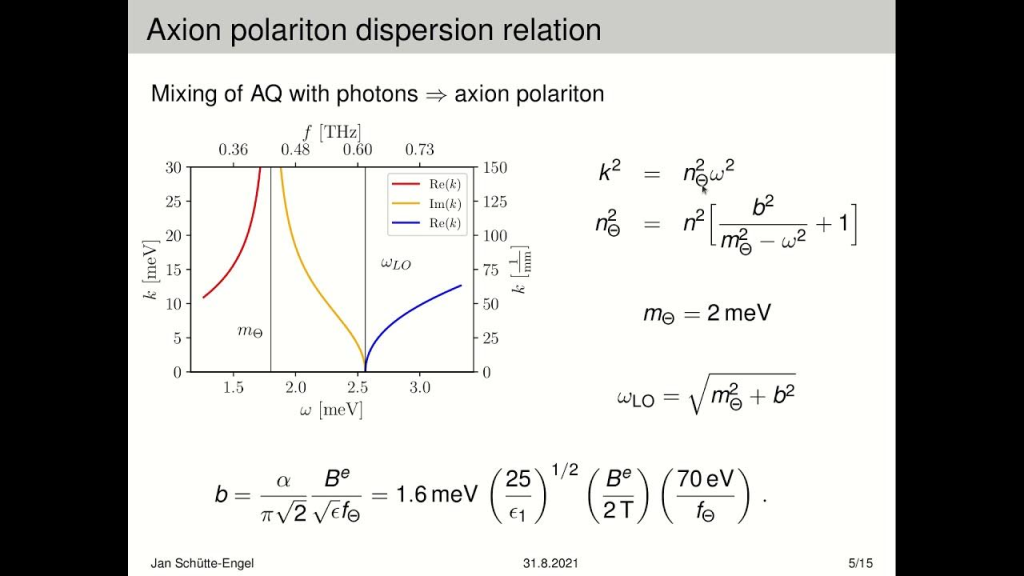
Axion quasiparticles are an exciting frontier in modern physics, serving as pivotal players in the quest to unlock the mysteries of dark matter. The elusive axions, theorized to constitute a significant portion of the universe’s mass, have long challenged scientists in the realm of particle physics. Recently, researchers have harnessed these unique quasiparticles within the context of manganese bismuth telluride, a groundbreaking material known for its extraordinary electronic properties. This innovative approach not only facilitates quasiparticle detection but also opens avenues for advancements in quantum technologies. As the world of particle physics continues to evolve, axion quasiparticles stand at the forefront of our understanding of the universe, bridging the gap between theoretical concepts and experimental reality.
In the realm of fundamental physics, researchers are delving into the fascinating domain of quasiparticles—specifically, the intriguing axion varieties. These theoretical constructs are integral to comprehending dark matter, the invisible mass that significantly influences cosmic structure and formation. Utilizing sophisticated materials like manganese bismuth telluride, scientists are making strides in simulating and detecting these axionic phenomena. The intersection of condensed matter and high-energy physics provides a rich landscape for understanding potential applications in quantum technologies. As we continue to explore these quasiparticle frameworks, their relevance for unraveling the complexities of dark matter becomes increasingly vital.
Understanding Axion Quasiparticles: The Key to Dark Matter Research
Axion quasiparticles, a theoretical concept rooted in particle physics, have recently gained attention as potential carriers of dark matter signals. With dark matter making up approximately 85% of the universe’s mass, understanding these elusive particles is crucial for cosmologists and physicists alike. By employing advanced techniques, researchers are leveraging the properties of material like manganese bismuth telluride to simulate the behavior of axions. These quasiparticles act as proxies for dark matter in experiments, allowing scientists to study their interactions with the material in ways that were previously impossible.
Through meticulous engineering and precision experiments, the team at Harvard and King’s College London is innovatively using axion quasiparticles to explore fundamental questions about the universe. The detection of these quasiparticles not only reinforces the theoretical framework of dark matter but also opens avenues for advancements in quantum technologies. As researchers refine their methodologies, they are optimistic that axion quasiparticles will offer profound insights into the nature of dark matter and the underlying fabric of the cosmos.
Manganese Bismuth Telluride: A Material of Choice for Quantum Technologies
Manganese bismuth telluride is not only selected for its semiconductor properties but also for its unique ability to support the formation of axion quasiparticles. As a two-dimensional crystal, it provides an ideal environment for the manipulation of quasiparticle dynamics, allowing researchers to observe and characterize their behavior under precise conditions. The engineering of this material involves advanced nano-fabrication techniques that can create layers only a few atoms thick, which is crucial for enhancing its quantum mechanical characteristics.
Furthermore, the remarkable properties of manganese bismuth telluride lend themselves to the quest for dark matter detection. By tuning its electronic structure, researchers can create conditions conducive to the necessary interactions needed to observe axion quasiparticles. This pioneering approach not only sheds light on fundamental physics but also paves the way for novel quantum applications that could revolutionize technology, thus illustrating the synergistic link between material science and particle physics.
Exploring the Implications of Axions in Particle Physics
The potential existence of axions opens up new dimensions in particle physics by challenging established paradigms and offering solutions to longstanding enigmas, especially regarding dark matter. The concept of axions proposes a method to integrate weaker forces and quantum effects into a coherent theoretical framework. In this regard, the work of researchers within the Harvard and King’s College team is pivotal; they provide experimental validation that could confirm the presence of these elusive particles and enhance our understanding of matter interactions at quantum levels.
Moreover, the investigation of axion quasiparticles contributes significantly to broader explorations in high-energy physics. As scientists delve deeper into understanding how these quasiparticles behave, insights could emerge that inform other areas of physics and technology, including innovations in quantum computing and precision measurements. With the ability to detect dark matter through these quasiparticle interactions, the study holds immense promise for unraveling the mysteries of the universe.
The Role of Quantum Technologies in Modern Research
Quantum technologies are rapidly transforming scientific research, particularly in the fields of particle physics and cosmology. Novel experimental techniques powered by quantum mechanics are enabling researchers to probe phenomena that were previously unverifiable. The utilization of axion quasiparticles as a detection mechanism exemplifies the intersection of quantum science and fundamental physics, promising to yield breakthroughs in our understanding of dark matter and the early universe.
In particular, harnessing quantum materials like manganese bismuth telluride not only advances the search for dark matter but also fosters innovations applicable to various technology sectors. These developments could lead to enhanced sensors, quantum computing resources, and new methodologies in scientific measurement, thereby advancing our capabilities across numerous scientific disciplines. The marriage between quantum technologies and particle physics heralds a new era of discovery with vast implications.
Innovative Methods for Quasiparticle Detection
The innovative methods employed in the detection of axion quasiparticles represent a significant leap forward in the field of particle physics. Utilizing advanced ultrafast laser optics, researchers can probe the dynamic behaviors of these quasiparticles with remarkable precision. The interaction between a dark matter axion and the quasiparticle generates detectable signals, establishing a groundbreaking method to indirectly confirm the presence of dark matter without direct observation.
These detection techniques are constantly evolving, reflecting the necessity of interdisciplinary cooperation among physicists, chemists, and engineers. As methodologies improve, the potential for discovering new phenomena increases, thereby enhancing our theoretical understanding of the universe. The innovative approaches to quasiparticle detection exemplify how modern technological advancements can intersect with fundamental science, promising to unravel the mysteries of dark matter and the quantum world.
Research Findings: Implications for Dark Matter Detection
The findings from the recent experiments have profound implications for dark matter detection. By showcasing a viable method to visualize axion quasiparticles, researchers have laid the groundwork for a new class of detectors that could significantly advance the search for dark matter. The concept likened to a ‘cosmic car radio’ demonstrates a novel approach to tuning into frequencies associated with axion interactions, suggesting that the team may be on the brink of major breakthroughs in dark matter research.
This progress highlights an exciting phase for researchers focused on dark matter, with the potential for rapid advancements akin to those witnessed in earlier physics discoveries, such as the Higgs boson. The combined effort of highly skilled teams from various institutions showcases how collaborative research can lead to impactful scientific revelations. Continued investment and support will be essential in the coming years, as future experiments could further illuminate the darkness that surrounds this enigmatic part of our universe.
The Future of Axion Research in Cosmology
The future of axion research stands on the brink of exhilarating discoveries. As the team at Harvard and other collaborating institutions refine their techniques and methodologies, they are preparing to deepen their inquiries into the properties of axion quasiparticles. The goal is to develop experiments with greater sensitivity and precision, which could drastically improve our ability to probe dark matter through quasiparticle interactions.
Advancements in this field could not only confirm the existence of axions but also enhance our understanding of the universe’s structure and evolution. If successful, this research may reshape our conception of particle physics and cosmology, elucidating the nature of dark matter. By continually evolving experiments in line with insights from quantum technologies, the researchers can remain at the frontier of discovery, potentially unlocking some of the universe’s best-kept secrets.
Cross-Disciplinary Approaches to Advanced Research
The ongoing research on axion quasiparticles exemplifies the powerful impact of cross-disciplinary collaboration among various scientific fields. By combining expertise from condensed matter physics, material chemistry, and high-energy physics, the researchers have created a multifaceted approach that enhances their exploratory potential. This integrative methodology cultivates a richer understanding of how different scientific domains can intersect to produce innovative solutions to complex problems, such as those posed by dark matter.
As the field evolves, fostering collaborative environments will be critical to pushing the boundaries of knowledge. By uniting diverse perspectives and skill sets, researchers can design more robust experiments and approach the analysis from various attributions, improving their chances of success in uncovering the elusive axions. The interplay between various branches of science illustrates how a shared commitment to discovery can lead to extraordinary advancements in our understanding of the universe.
The Significance of Interdisciplinary Collaboration in Scientific Progress
Interdisciplinary collaboration is becoming increasingly significant in scientific progress, especially in areas as complex as particle physics and dark matter research. The pursuit of understanding axion quasiparticles highlights the need for cooperation among experts from different disciplines, such as physics, chemistry, engineering, and materials science. This synergy fosters innovation and facilitates the development of cutting-edge technologies necessary for new discoveries.
The successful development of axion quasiparticles as a method for detecting dark matter demonstrates how interdisciplinary approaches yield fruitful results. Each field contributes unique insights that lead to comprehensive understanding and enhanced experimental outcomes. As researchers continue to tackle cosmic mysteries, the importance of building collaborative networks will be paramount in advancing our grasp of the universe and its fundamental components.
Frequently Asked Questions
What are axion quasiparticles and how are they related to dark matter?
Axion quasiparticles are theoretical simulations of axion particles, which are postulated as potential components of dark matter. Their unique behavior can be harnessed to detect actual axions, suggesting their critical role in understanding the mysterious nature of dark matter.
How can axion quasiparticles contribute to advances in quantum technologies?
The study of axion quasiparticles opens new avenues in quantum technologies by enabling the development of highly sensitive detectors. These detectors, based on materials like manganese bismuth telluride, could exploit axion quasiparticle dynamics to create innovative applications in quantum information and optics.
What role do manganese bismuth telluride play in axion quasiparticle research?
Manganese bismuth telluride provides a unique platform for creating axion quasiparticles due to its special electronic and magnetic properties. Researchers utilize its 2D crystal structure to enhance the detection capabilities of axion quasiparticles, facilitating the investigation into their role as dark matter candidates.
How do researchers use axion quasiparticles to detect dark matter?
Researchers employ axion quasiparticles as potential detectors of dark matter by tuning into specific frequencies that axion particles might emit. When a dark matter axion impacts the material, it excites the quasiparticle, allowing scientists to identify and confirm the existence of dark matter signals.
What experimental techniques are utilized in the study of axion quasiparticles?
To study axion quasiparticles, researchers use sophisticated techniques such as ultrafast laser optics and precision nano-fabrication methods. These techniques allow them to observe the dynamics of axion quasiparticles in a carefully controlled environment, turning theoretical predictions into observable phenomena.
What is the significance of confirming the existence of axions in particle physics?
Confirming axions would address some of the most pressing questions in particle physics, particularly regarding the composition of dark matter. Since axions may constitute a significant portion of the universe’s mass, their identification could revolutionize our understanding of cosmology and fundamental physics.
What are the potential future applications of axion quasiparticles in science?
Axion quasiparticles could lead to groundbreaking advancements in particle physics and quantum technologies. Their properties may enable the development of highly accurate dark matter detectors and novel optical devices, benefiting various fields within science and technology.
How do axion quasiparticles fit into the larger framework of particle physics theories?
Axion quasiparticles offer a tangible representation of theoretical axion particles predicted in leading particle physics models. By exploring these quasiparticles, researchers can test hypotheses about dark matter and further refine the standard model of particle physics.
What collaborative efforts are driving the research on axion quasiparticles?
Research on axion quasiparticles involves collaboration among institutions like Harvard, King’s College London, UC Berkeley, and others. This interdisciplinary approach combines expertise in condensed-matter physics, material chemistry, and high-energy physics, enhancing the exploration of axion-related phenomena.
What challenges do researchers face while studying axion quasiparticles?
Researchers encounter challenges such as the air-sensitivity of materials like manganese bismuth telluride and the need for precise experimental conditions to observe axion quasiparticles. Overcoming these hurdles is critical for accurately probing their properties and potential implications for dark matter research.
| Key Point | Description |
|---|---|
| Purpose of Research | To confirm the existence of axions, which are theorized to make up dark matter and provide insights into the cosmos. |
| Breakthrough Experiment | A team from Harvard and King’s College London uses quasiparticles in an experiment to search for axions. |
| Axion Quasiparticles | Simulations of axion particles that can act as detectors for actual dark matter particles. |
| Material Used | Researchers utilized manganese bismuth telluride, known for its unique magnetic and electronic properties. |
| Innovative Techniques | Ultrafast laser optics and sophisticated measurement tools to study the dynamics of axion quasiparticles. |
| Future Implications | New observational capabilities may help discover dark matter in 15 years, offering profound implications for physics. |
Summary
Axion quasiparticles are a crucial focus of recent research, aimed at confirming the existence of axions that are believed to comprise dark matter. This revolutionary study, led by scientists from Harvard and King’s College London, sets the stage for new technologies and deeper understanding of the universe’s composition. By harnessing axion quasiparticles, researchers can potentially detect dark matter, which remains one of the cosmos’s biggest mysteries. The interdisciplinary approach demonstrated in the experiments showcases the significant role that innovative materials and techniques play in advancing our knowledge of particle physics, indicating a bright future for axion research.


